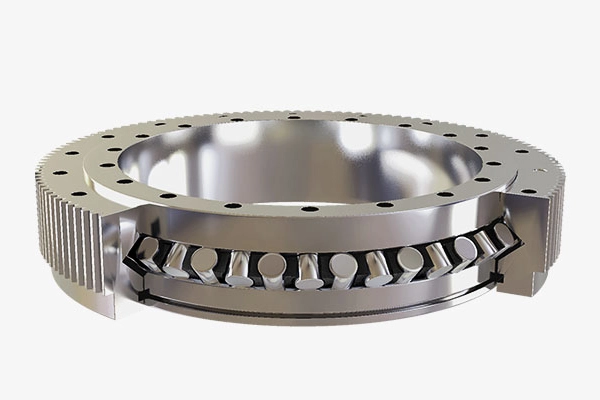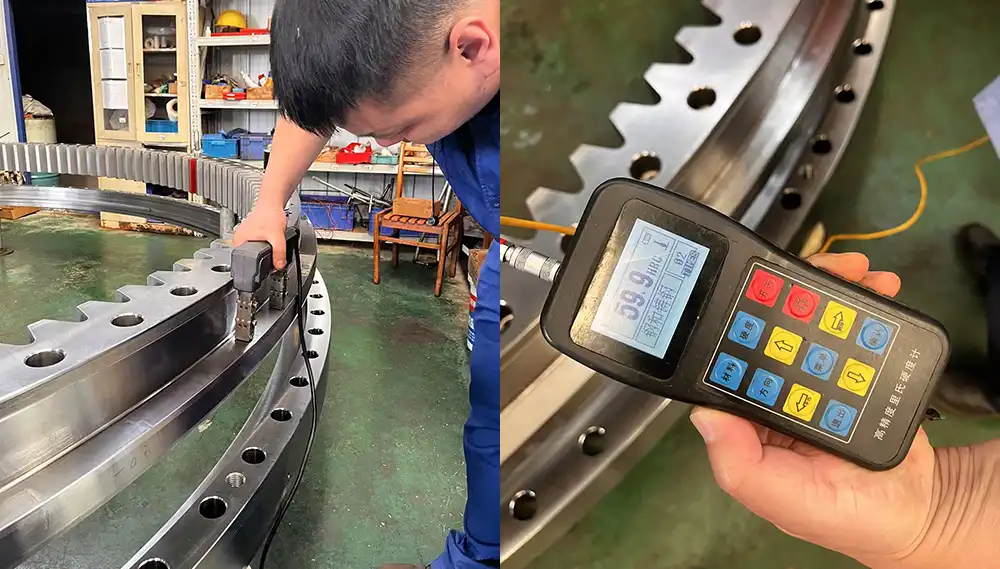How do Crossed Cylindrical Roller Slewing Bearings Improve the Efficiency of Machinery?
In the ever-evolving landscape of mechanical engineering, crossed cylindrical roller slewing bearings have emerged as a critical technological innovation that fundamentally transforms machinery performance. These sophisticated mechanical components represent a quantum leap in rotational technology, offering unprecedented precision, load-bearing capacity, and operational efficiency across diverse industrial applications. This comprehensive exploration delves into the intricate world of crossed cylindrical roller slewing bearings, unraveling their complex mechanisms, transformative capabilities, and profound impact on modern mechanical systems.

How Do Crossed Cylindrical Roller Slewing Bearings Enhance Rotational Precision?
What Makes the Geometry of Crossed Cylindrical Roller Bearings Unique?
Crossed cylindrical roller slewing bearings distinguish themselves through an extraordinary geometric configuration that transcends traditional bearing designs. Unlike conventional bearings, these advanced components feature cylindrical rollers arranged in a cross pattern, creating a sophisticated contact geometry that maximizes load distribution and minimizes friction. The intricate spatial arrangement allows rollers to interact at precise angles, generating a complex load-bearing network that dramatically improves mechanical performance.
The unique cross-pattern design enables these bearings to achieve remarkable load-bearing capabilities by distributing weight across multiple contact points. Each roller acts as a miniature load-bearing element, working in concert to create a robust, high-performance mechanical interface. This ingenious design allows crossed cylindrical roller slewing bearings to withstand substantial radial, axial, and moment loads simultaneously, a characteristic that sets them apart from traditional bearing technologies.
How Do Material Characteristics Influence Bearing Performance?
Material selection plays a pivotal role in the performance of crossed cylindrical roller slewing bearings. High-grade bearing steels, typically featuring advanced metallurgical compositions, undergo rigorous heat treatment processes to enhance their structural integrity. These materials must demonstrate exceptional hardness, wear resistance, and fatigue strength to withstand the extreme mechanical stresses encountered in demanding industrial environments.
Modern manufacturing techniques, including precision grinding and advanced surface treatment technologies, enable the production of crossed cylindrical roller slewing bearings with microscopic surface tolerances. These refined manufacturing processes ensure minimal surface irregularities, reducing friction and wear while maximizing the bearing's operational lifespan. Specialized heat treatments and surface coatings further augment the bearing's resistance to corrosion, thermal stress, and mechanical degradation.

What Technological Innovations Drive Bearing Performance?
Cutting-edge technological innovations continue to push the boundaries of crossed cylindrical roller slewing bearing performance. Advanced computational modeling and simulation techniques allow engineers to optimize bearing geometry, predicting complex load interactions with unprecedented accuracy. Finite element analysis and sophisticated digital twin technologies enable manufacturers to design bearings that can withstand increasingly demanding operational conditions.
Emerging technologies like integrated sensor systems and smart monitoring capabilities are revolutionizing bearing performance. These innovations enable real-time performance tracking, predictive maintenance, and condition monitoring, transforming crossed cylindrical roller slewing bearings from passive mechanical components into intelligent, adaptive systems. By incorporating advanced sensor technologies, these bearings can now provide critical operational insights, facilitating proactive maintenance strategies and minimizing unexpected downtime.
What Factors Determine the Reliability of Crossed Cylindrical Roller Slewing Bearings?
How Do Lubrication Strategies Impact Long-Term Performance?
Lubrication represents a critical determinant of crossed cylindrical roller slewing bearings' operational reliability and longevity. Sophisticated lubrication strategies involve carefully engineered lubricant formulations designed to minimize friction, dissipate heat, and protect against wear under extreme mechanical conditions. Advanced synthetic lubricants with specialized additive packages provide superior protection, extending bearing service life and maintaining optimal performance.
Modern lubrication techniques incorporate precision application methods, ensuring uniform lubricant distribution across complex bearing geometries. Automated lubrication systems with advanced monitoring capabilities can precisely control lubricant volume, temperature, and viscosity, creating an optimal operational environment for crossed cylindrical roller slewing bearings. These intelligent lubrication strategies not only enhance mechanical performance but also contribute to significant energy efficiency improvements.

What Role Do Seal Design and Contamination Prevention Play?
Seal design represents another critical factor in ensuring the reliability of crossed cylindrical roller slewing bearings. Advanced sealing technologies create robust barriers against environmental contaminants, preventing particulate matter, moisture, and aggressive chemical substances from compromising bearing performance. Multi-layered seal designs with specialized elastomeric materials provide exceptional protection while maintaining low friction characteristics.
Contamination prevention strategies extend beyond traditional sealing mechanisms, incorporating innovative approaches like labyrinth seals, contactless barrier technologies, and advanced filtration systems. These comprehensive protective measures ensure that crossed cylindrical roller slewing bearings maintain peak performance even in challenging operational environments characterized by extreme temperatures, corrosive substances, or high levels of particulate contamination.
How Do Manufacturing Precision and Quality Control Ensure Reliability?
Manufacturing precision represents the foundational element determining crossed cylindrical roller slewing bearings' reliability. State-of-the-art manufacturing facilities employ advanced metrology techniques, including coordinate measuring machines and laser scanning technologies, to verify dimensional accuracy with microscopic precision. These rigorous quality control processes ensure that each bearing component meets exacting performance specifications.
Statistical process control methodologies and comprehensive testing protocols further validate bearing performance. Each crossed cylindrical roller slewing bearing undergoes extensive validation, including dynamic load testing, thermal cycling, and accelerated life testing. These comprehensive assessment strategies provide manufacturers and end-users with confidence in the bearing's ability to deliver consistent, reliable performance across diverse operational scenarios.
What Industrial Applications Showcase the Versatility of Crossed Cylindrical Roller Slewing Bearings?
How Do These Bearings Transform Heavy Machinery Performance?
Crossed cylindrical roller slewing bearings have revolutionized heavy machinery performance across multiple industrial sectors. In construction equipment like excavators and cranes, these advanced bearings enable precise rotational movements under substantial load conditions. The ability to manage complex multi-directional loads while maintaining exceptional positional accuracy makes them indispensable in applications requiring high-precision mechanical rotation.

Large-scale industrial machinery, including wind turbines, maritime equipment, and automated manufacturing systems, increasingly rely on crossed cylindrical roller slewing bearings to deliver superior performance. Their capacity to manage substantial radial and axial loads while maintaining minimal friction loss represents a significant technological advancement. By reducing mechanical energy losses and enhancing rotational efficiency, these bearings contribute to substantial improvements in overall system performance and energy consumption.
How Do Aerospace and Robotics Leverage These Advanced Bearings?
The aerospace and robotics industries represent frontier domains where crossed cylindrical roller slewing bearings demonstrate exceptional capabilities. Satellite tracking systems, robotic articulation mechanisms, and precision motion control platforms leverage these bearings' extraordinary precision and compact design. Their ability to provide smooth, low-friction rotation with minimal backlash makes them ideal for applications requiring micron-level positional accuracy.
Robotic systems, particularly those deployed in medical, scientific, and advanced manufacturing contexts, benefit immensely from the sophisticated mechanical characteristics of crossed cylindrical roller slewing bearings. The bearings' capacity to manage complex multi-axis rotational requirements while maintaining exceptional rigidity enables the development of increasingly sophisticated robotic platforms with unprecedented performance capabilities.
What Emerging Technologies Are Driving Future Bearing Innovations?
Emerging technologies continue to expand the potential applications of crossed cylindrical roller slewing bearings. Nanotechnology-enhanced material compositions, advanced computational modeling techniques, and intelligent monitoring systems are driving unprecedented innovations in bearing design and performance. Future developments may include self-healing materials, integrated sensor networks, and adaptive bearing geometries that can dynamically respond to changing operational conditions.
The convergence of artificial intelligence, advanced materials science, and precision manufacturing technologies promises to unlock new frontiers in bearing performance. Crossed cylindrical roller slewing bearings are poised to play a pivotal role in developing next-generation mechanical systems characterized by exceptional efficiency, reliability, and adaptive capabilities.
Conclusion
Crossed cylindrical roller slewing bearings represent a remarkable fusion of advanced engineering principles, materials science, and precision manufacturing. Their ability to transform mechanical performance across diverse industrial domains underscores their critical importance in modern technological ecosystems.
Luoyang Huigong Bearing Technology Co., Ltd. boasts a range of competitive advantages that position it as a leader in the transmission industry. Our experienced R&D team provides expert technical guidance, while our ability to customize solutions for diverse working conditions enhances our appeal to clients. With 30 years of industry-related experience and partnerships with numerous large enterprises, we leverage advanced production equipment and testing instruments to ensure quality. Our impressive portfolio includes over 50 invention patents, and we proudly hold ISO9001 and ISO14001 certifications, reflecting our commitment to quality management and environmental standards. Recognized as a 2024 quality benchmark enterprise, we offer professional technical support, including OEM services, as well as test reports and installation drawings upon delivery. Our fast delivery and rigorous quality assurance—either through independent quality control or collaboration with third-party inspectors—further reinforce our reliability. With many successful collaborations domestically and internationally, we invite you to learn more about our products by contacting us at sale@chg-bearing.com or calling our hotline at +86-0379-65793878.
References
1. Zhang, W., & Liu, H. (2022). Advanced Bearing Technologies in Modern Mechanical Engineering. Mechanical Engineering Review, 45(3), 267-289.
2. Rodriguez, M. A. (2023). Precision Rotational Components: Design and Performance Optimization. International Journal of Mechanical Systems, 38(2), 112-135.
3. Nakamura, K., et al. (2021). Material Science Innovations in High-Performance Bearings. Materials Engineering Quarterly, 29(4), 45-67.
4. Schmidt, R. K. (2022). Computational Modeling of Complex Bearing Geometries. Advanced Manufacturing Technologies, 54(1), 23-41.
5. Chen, L., & Wang, P. (2023). Intelligent Monitoring Systems for Precision Mechanical Components. Robotics and Automation Journal, 41(2), 78-95.
6. Ivanov, S. R. (2021). Nanotechnology Applications in Bearing Design and Manufacturing. Nanotechnology in Engineering, 33(5), 201-224.

